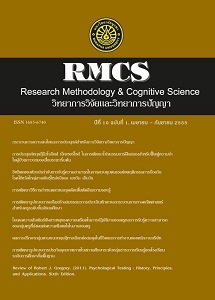การพัฒนาวิธีการกำหนดคะแนนจุดตัดเพื่อตัดสินความรอบรู้
Main Article Content
Abstract
A Proposed of Cut-Off Score Method for Mastery Judgment
Prapassorn Wongdee, Samran Mejang, Rattana Buosonte and Pakorn Prachanban
Naresuan University, Thailand
The purposes of this study were to propose the cut–off score method for mastery judgment and to compare the efficiency of cut–off score method between the cut–off score method for mastery judgment and the cut–off score of Glass’s Decision Method. The efficiency of cut-off score method considered from the consistency or validity of mastery learners by using Phi coefficiency and transformed to Fisher Z, then compared with Z–test respectively. The set of secondary data of students that were a freshman in academic year 2009; O-NET scores data at grade 12 in Mathematics and English, grade point average of high school education in Mathematics and Foreign Language, cumulative grade point average at the end of first year in Bachelor’s Degree.
The research results consisted of :
1. The cut–off score method for mastery judgment integrated the Item Response Theory to analyze the ability score of a criterion–referenced test and then set a cut–off score. The cut–off score categorized persons into mastery and non-mastery and judged with the external criterion that also devided persons into mastery and non-mastery. The suitable cut–off score got the minimize Error of Classification Index (ECI) that the researcher formulated as follows:
ECI= 
2. Most of the research results indicated that the cut–off score method for mastery judgment had higher consistency coefficient than the cut–off score of Glass’s Decision Method. Some of the research results indicated that the cut–off score method for mastery judgment and the cut–off score of Glass’s Decision Method had the equal consistency coefficient.

